Ikkyo Complete 5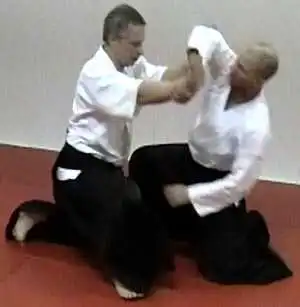 Suwariwaza — Seated defense against seated attacksSuwariwazaSuwariwaza is the training where both tori and uke are seated on the floor, and walking on their knees. It comes from samurai days. The Japanese warrior neeeded to train defense from when seated. Nowadays, other advantages with suwariwaza emerge: it's great for learning to be balanced and stable, and to economize one's movements.
SuwariwazaSuwariwaza ikkyo, omote and ura, on all the attack forms explained below. Many more aikido videos on my YouTube Channel.
The best way to do suwariwaza, is to make its techniques as similar as possible to tachiwaza, the training where both tori and uke stand up. You can also say that tachiwaza techniques should be made similar to suwariwaza. The main difference between them is that in suwariwaza you tend to minimalize your movements on the tatami — taking away unnecessary steps, and shortening the ones needed. This is good to apply also to tachiwaza. Another interesting difference is that in suwariwaza it's not really possible to lower yourself anymore. Lowering oneself is often used in tachiwaza, to get additionally stable or to sneak under an obstacle, and so on. In suwariwaza, other solutions are needed — so here is an unavoidable difference between the two. In aihanmi katatedori there is no reason for making the suwariwaza ikkyo any different from tachiwaza. Make sure that you have good balance from the very start, or uke might push you back at the initial attack. Extend your arms from the start, and advance firmly at the step where you have your hands on uke's arm — to assure that uke loses balance, and not you. In ura, you will find that you do not need to move very much at all, when you spin around with uke. In aihanmi and this continuous jutai, it's not necessary to begin the ura on the omote side. You can go directly to the ura side — if uke is not pushing too much on the aihanmi wrist grip. Both omote and ura are on the video clip.
Gyakuhanmi katatedori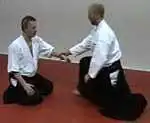 Here, as well as on aihanmi, the continuous jutai timing is used, with no break or retreat between one technique and the next. The classical way of training suwariwaza.
Here, as well as on aihanmi, the continuous jutai timing is used, with no break or retreat between one technique and the next. The classical way of training suwariwaza.There is no need to do ikkyo any different in suwariwaza than in tachiwaza. Avoid bringing uke down too much, in the initial movement, or you will have problems getting uke's arm up again for the ikkyo move. On this video clip, I get free from uke's wrist grip when I turn uke's arm upward. I move my wrist in toward uke's body, through the gap between the thumb and the other fingers. There are other ways to do it — for example with a big sweep with the other arm, as I do on the tachiwaza video clip. The solution here is more suitable for the continuous jutai timing, but both are possible. In gyakuhanmi, you need to start ura on the omote side, or you will hardly be able to get uke's arm in position for the ikkyo. Both omote and ura are on the video clip.
Shomenuchi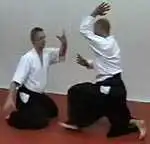 Like the above aihanmi and gyakuhanmi katatedori, shomenuchi is usually done in continuous jutai timing, where uke hardly gets the chance to even get up properly before the next ikkyo commences.
Like the above aihanmi and gyakuhanmi katatedori, shomenuchi is usually done in continuous jutai timing, where uke hardly gets the chance to even get up properly before the next ikkyo commences.Because of this rhythm, it's usually jut the first shomen that is uchi, the downward strike — the following ones are more like shomenate, the forward strike. It's rather more of a block than a strike, actually, necessary because of tori's arm extended toward uke's face. It looks more like tori is attacking, than that uke is. In this timing, when uke doesn't get a chance to do a proper shomenuchi, it's not necessary to start the ura by going first to the omote side. You can go directly to the ura side, because you can still steer uke's arm into the ikkyo technique. When the attack is a proper shomenuchi, though, you will need to begin at the omote side. Both omote and ura are on the video clip.
Yokomenuchi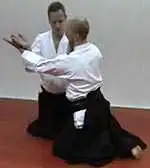 Certainly, yokomenuchi ikkyo in suwariwaza can be trained in continuous jutai, like the above techniques, but on this video clip I do just one omote and one ura, for clarity.
Certainly, yokomenuchi ikkyo in suwariwaza can be trained in continuous jutai, like the above techniques, but on this video clip I do just one omote and one ura, for clarity.The parrying arm movement is the same as in any gyakuhanmi related technique, such as katadori, munedori, ryotedori, et cetera. The parry is not blocking the attack, but pushing it forward, extending it. Tori's other arm simultaneously makes an atemi to uke's face. It's the same way of doing the technique as in tachiwaza, where both are standing up. In ura, it is necessary first to go to the omote side, then over to the ura side. If not, it is very difficult to get uke's arm in the position neeeded for ikkyo. Both omote and ura are on the video clip.
Ryotedori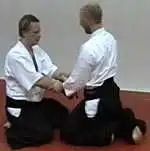 Ryotedori is done in the same way as gyakuhanmi katatedori. Uke's second grip matters very little, and is no problem for tori to complete the technique. The grip is released by the arm and body movement tori makes in the ikkyo, without any special attention to it needed.
Ryotedori is done in the same way as gyakuhanmi katatedori. Uke's second grip matters very little, and is no problem for tori to complete the technique. The grip is released by the arm and body movement tori makes in the ikkyo, without any special attention to it needed.Make sure to make your initial taisabaki move out of line of uke's forward direction. Your arm movement extends uke forward, which can be done effortlessly. Your other arm is making an atemi movement toward uke's face, but in ryotedori it is not necessary to make it sharp or quick — here it's more to start releasing the grip and to prepare for the ikkyo technique. Because you automatically have uke's hand in a good grip for it, you apply the osae, pinning, with pressure on uke's wrist. The way of doing ikkyo is the same as in tachiwaza, where both tori and uke stand up. In ura, remember to start to the omote side, and then go to the ura side. Otherwise it's difficult to get uke's arm in position for the ikkyo. Both omote and ura are on the video clip.
Ryokatadori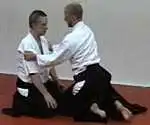 Ryokatadori ikkyo is done the same as katadori, when just one shoulder is grabbed. It's quite identical also to ikkyo on ryotedori, ryosodedori, and so on. Don't worry about uke's second shoulder grip — the arm you're not doing ikkyo on. That grip will be released by your arm and body movement, without any special attention to it needed.
Ryokatadori ikkyo is done the same as katadori, when just one shoulder is grabbed. It's quite identical also to ikkyo on ryotedori, ryosodedori, and so on. Don't worry about uke's second shoulder grip — the arm you're not doing ikkyo on. That grip will be released by your arm and body movement, without any special attention to it needed.Because you extend uke forward in your initial taisabaki move, you are able to get in on uke's side, without that arm resisting. When uke is pulled forward, uke's arms will get a tendency to bend, because the body is trying to remain in balance. In ura, you need to start on the omote side, not on the ura side, or it's very difficult indeed to get uke's arm in position for ikkyo. Both omote and ura are on the video clip.
Munedori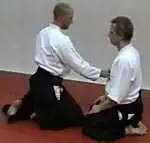 Munedori is done very similarly to for example katadori. With your initial arm movement, you extend uke forward. Also, you bend uke's wrist, which makes the grip weaken a little. The grip is released when you extend your arm for the ikkyo. The munedori grip can be quite strong and difficult, so it's important to do the technique properly and focused.
Munedori is done very similarly to for example katadori. With your initial arm movement, you extend uke forward. Also, you bend uke's wrist, which makes the grip weaken a little. The grip is released when you extend your arm for the ikkyo. The munedori grip can be quite strong and difficult, so it's important to do the technique properly and focused.Ura starts the same way as omote. Not until the moment when you start to extend your arm in the ikkyo movement, do you choose omote or ura. Remain centered all through, keeping your arms in front of you, or you may lose your balance. Both omote and ura are on the video clip.
Katadori menuchi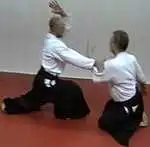 In katadori menuchi, where uke both grabs tori's wrist and makes shomenuchi with the other hand, tori can choose to do the technique on the katadori arm or on the shomen arm. In ikkyo, though, it's necessary to do it on the katadori arm. Uke's shomenuchi arm will otherwise be blocked by the katadori grip, when tori tries to do the ikkyo on it.
In katadori menuchi, where uke both grabs tori's wrist and makes shomenuchi with the other hand, tori can choose to do the technique on the katadori arm or on the shomen arm. In ikkyo, though, it's necessary to do it on the katadori arm. Uke's shomenuchi arm will otherwise be blocked by the katadori grip, when tori tries to do the ikkyo on it.I really think that one should not wait for the shomenuchi, but start immediately with a technique when the katadori grip comes — if that is before the shomeuchi. Usually in aikido, though, tori awaits the shomenuchi before starting the actual technique. Of course there is a taisabaki move away from the shomenuchi — but it's to the wrong side, if a regular katadori ikkyo is intended. The reason for this alternative start of the katadori ikkyo is that a quick shomenuchi might block the ikkyo, if done in the regular katadori way. So, tori's first step is to uke's katadori side, and the shomenuchi is warded off similarly to how it's done in a regular shomenuchi. Next, you continue further on uke's katadori side, to get that arm into the ikkyo movement. Make sure that you don't bring uke's shomenuchi-hand with you. The katadori grip is released when you extend your arm. The katadori menuchi ikkyo is a little easier to do ura than omote, because tori enters so much into the ura side already at the beginning. If the shomen hand is armed, for example witha a tanto, knife, then it feels significantly safer to do ura than omote. They are both quite possible, though. Both omote and ura are on the video clip.
Stefan Stenudd
IKKYO COMPLETE
AIKIDO PRACTICEIntroductionAikido Techniques — all the basic movesAttacks in Aikido
Tantodori — knife defenseAikiken — aikido sword techniquesJo 31 Kata in four directionsAikibatto sword and staff exercisesAiki — joining energiesKi exercisesAikido Video ClipsAikido PhotosMy aikido dojo in Malmö, SwedenMy aikido seminarsAIKIDO THEORYMy Aikido BioAikido GlossaryTanden, the CenterAikido InksAikido as Self-DefenseRunning a DojoAikido is TrueOsensei and EinsteinAikiWeb ColumnsAikido Books ReviewedDie deutsche Version meines Aikido-Buches onlineAikido på svenskaAbout CookiesMy Other WebsitesCREATION MYTHSMyths in general and myths of creation in particular.
TAOISMThe wisdom of Taoism and the Tao Te Ching, its ancient source.
LIFE ENERGYAn encyclopedia of life energy concepts around the world.
QI ENERGY EXERCISESQi (also spelled chi or ki) explained, with exercises to increase it.
I CHINGThe ancient Chinese system of divination and free online reading.
TAROTTarot card meanings in divination and a free online spread.
ASTROLOGYThe complete horoscope chart and how to read it.
MY AMAZON PAGE
MY YOUTUBE AIKIDO
MY YOUTUBE ART
MY FACEBOOK
MY INSTAGRAM
MY TWITTER
STENUDD PÅ SVENSKA
|
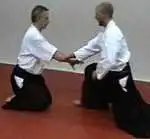
 Aikido Principles
Aikido Principles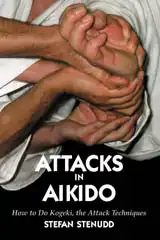 Attacks in Aikido
Attacks in Aikido Aikibatto
Aikibatto
